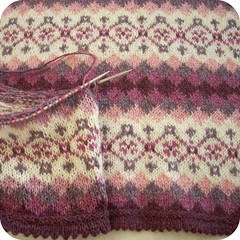Saturday, 31 July 2010
"Kungsängslilja" no 2: steeks
Most important, I don't make use of sewing machines anymore. For a long time I did before cutting the armholes open for my knitted cylinders - and overused them too out of fear the sweater would unravel. Those seams are rather stiff, not so much to make the sweaters uncomfortable to wear, but enough to annoy me.
However, I do my best to see them as proof that my confidence and skills have developed, since I don't feel the slightest need to use a sewing machine today. In addition, I must say it's very satisfying not having to use a machine at all as I like doing as much as possible by hand. It's nice being able to do things without depending on electricity!
Saturday, 10 July 2010
"Kungsängslilja" no 2
I'm knitting a new version of a vest I made in November. They're practically identical; however, I'm modifying the shape slightly and have chosen a different shade of lighter pink. I think I prefer the new combination. There's more contrast in the first version, which I think creates visual interest, but the softer change in the second version appeals to me too.
Hard as it may be to believe, I had to have a break from knitting for a few days as my left shoulder was too sore. I first thought it might be due to spending an afternoon crocheting the bind-off edge around the Springtime shawl, but have decided to blame it on cooking instead. (In this case cooking=boiling some potatoes.)
This is my 100th blog post! I had no idea last spring there were so many things I'd want to write about my knitting.
Saturday, 3 July 2010
Springtime shawl: dry
Here's a photo that shows the pattern better than the one in my previous post, where the shawl is folded in half on a blue towel. All I need now is an owner! :-D
6 July:
Rats! I accidentally deleted a new comment I was about to open. My apologies to whoever wrote it!
Friday, 2 July 2010
Blocking the Springtime shawl
I've folded the shawl in half to make it easier to block; not only out of a lack of space, but mainly to make sure the two halves become identical in size and shape.
It's a method I've tried before and I think it's far easier than measuring and rearranging the shawl and all the needles. When it's dry I'm going to dampen the middle of the back and reblock that part to avoid a crease.

Blocking has made it grow considerably in size, from each of the three triangles measuring 46x100 cm (18x39½ in) to 75x120 cm (29½x42 in). In this photo you can also see how much yarn I ended up not using - a close call!
Actually, I had to change my plans and skip the border along the top, realizing there wouldn't be enough yarn after all. Chart C (the big squares without leaves) was far more yarn-consuming than I expected. I had taken it into account how much many more repeats there would be, but hadn't studied the charts closely enough to discover how many more stitches there are in some rows. For example, a repeat consists of 24 stitches in one row, but 32 in another. That makes quite a difference when a row consists of 18 repeats!
This is my first attempt at a crocheted bind-off; I think it suits the pattern very well and it wasn't difficult, so I'm more than likely to do it again. After some experimenting I decided a chain of five stitches would be enough; the pattern has nine, but considering how little yarn I have left it was definitely a good decision to make them shorter.



